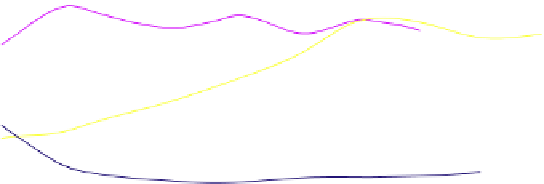Biomedical Engineering Reference
In-Depth Information
400
350
300
250
200
150
0
1
2
3
4 5
Test cycle number
6
7
8
9
10
Ni + IF-WS
2
coating
Without coating
Ni coating
FIGURE 13.11
Dependence of the friction force between bracket and SS archwire on the test cycle number (10
angulation).
slot increases causing a higher friction at the surface of uncoated wire. It is probably at this point
on the coated wire that the release of a few IF NP from the film into the tribological interface and
their rolling and exfoliation occurs, resulting in the formation of a solid lubricant film on the slid-
ing wire. The higher load at this point brings the asperities of the mating surfaces in straight contact
causing the fluid (saliva in the mouth) to be squeezed out of the gap between the wire and slot,
relying on the excellent tribological behavior of the solid lubricant film to allow the sliding of the
archwire. When the two materials are made of SS, as is the case with the uncoated wire a high fric-
tion coefficient is obtained. The presence of WS
2
nanosheets at the interface under high loads leads
to a very facile sliding between these sheets thereby reducing the coefficient of friction.
13.4.4.2
SS wires with IF-WS
2
impregnated in electrocodeposition of nickel film
Coated and uncoated SS rectangular archwires were engaged into brackets, which were attached
to a special device set at 10
angulations to the wire (
Figure 13.10
). The wire is connected on
the top to the load gauge and on the bottom to the 150 g (1.5 N) weight. The device is connected
to the base of a testing machine and pulled down at a constant speed of 10 mm/min to a distance
of 5 mm. The tests results showed (
Figure 13.11
) that friction forces between the rectangular
archwire and the self-ligating bracket were reduced on the coated wire by up to 60% compared
to the uncoated at the 10
angulation. Therefore, coated SS archwires with a composite Ni
IF-
WS
2
offers an opportunity to substantially reduce the friction force during orthodontic tooth
movement
[41]
.
1
13.4.4.3
Ni
Ti wires with cobalt and IF-WS
2
film by electroplating procedure
Friction measurements of the coated Ni
Ti wires were made using a device designed to simulate
sliding movement within a bracket system assembled to a Twin Column Testing Machine LR10K
with 10 kN load cell Instron system
[43,44]
(
Figure 13.12
). The simulation device consisted of a
horizontal mobile plate bearing SS brackets. The tested Ni
Ti rectangular wire (7 cm long),

























































